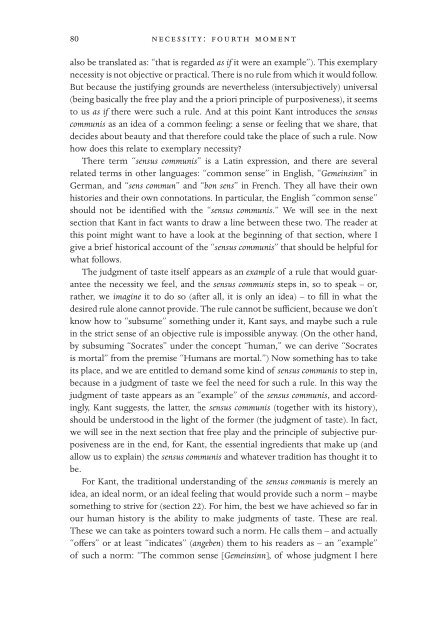AN INTRODUCTION TO KANT'S AESTHETICS
AN INTRODUCTION TO KANT'S AESTHETICS
AN INTRODUCTION TO KANT'S AESTHETICS
You also want an ePaper? Increase the reach of your titles
YUMPU automatically turns print PDFs into web optimized ePapers that Google loves.
80 NECESSITY: FOURTH MOMENT<br />
also be translated as: “that is regarded as if it were an example”). This exemplary<br />
necessity is not objective or practical. There is no rule from which it would follow.<br />
But because the justifying grounds are nevertheless (intersubjectively) universal<br />
(being basically the free play and the a priori principle of purposiveness), it seems<br />
to us as if there were such a rule. And at this point Kant introduces the sensus<br />
communis as an idea of a common feeling: a sense or feeling that we share, that<br />
decides about beauty and that therefore could take the place of such a rule. Now<br />
how does this relate to exemplary necessity?<br />
There term “sensus communis” is a Latin expression, and there are several<br />
related terms in other languages: “common sense” in English, “Gemeinsinn” in<br />
German, and “sens commun” and “bon sens” in French. They all have their own<br />
histories and their own connotations. In particular, the English “common sense”<br />
should not be identified with the “sensus communis.” We will see in the next<br />
section that Kant in fact wants to draw a line between these two. The reader at<br />
this point might want to have a look at the beginning of that section, where I<br />
give a brief historical account of the “sensus communis” that should be helpful for<br />
what follows.<br />
The judgment of taste itself appears as an example of a rule that would guarantee<br />
the necessity we feel, and the sensus communis steps in, so to speak – or,<br />
rather, we imagine it to do so (after all, it is only an idea) – to fill in what the<br />
desired rule alone cannot provide. The rule cannot be sufficient, because we don’t<br />
know how to “subsume” something under it, Kant says, and maybe such a rule<br />
in the strict sense of an objective rule is impossible anyway. (On the other hand,<br />
by subsuming “Socrates” under the concept “human,” we can derive “Socrates<br />
is mortal” from the premise “Humans are mortal.”) Now something has to take<br />
its place, and we are entitled to demand some kind of sensus communis to step in,<br />
because in a judgment of taste we feel the need for such a rule. In this way the<br />
judgment of taste appears as an “example” of the sensus communis, and accordingly,<br />
Kant suggests, the latter, the sensus communis (together with its history),<br />
should be understood in the light of the former (the judgment of taste). In fact,<br />
we will see in the next section that free play and the principle of subjective purposiveness<br />
are in the end, for Kant, the essential ingredients that make up (and<br />
allow us to explain) the sensus communis and whatever tradition has thought it to<br />
be.<br />
For Kant, the traditional understanding of the sensus communis is merely an<br />
idea, an ideal norm, or an ideal feeling that would provide such a norm – maybe<br />
something to strive for (section 22). For him, the best we have achieved so far in<br />
our human history is the ability to make judgments of taste. These are real.<br />
These we can take as pointers toward such a norm. He calls them – and actually<br />
“offers” or at least “indicates” (angeben) them to his readers as – an “example”<br />
of such a norm: “The common sense [Gemeinsinn], of whose judgment I here



